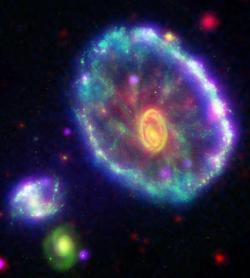
A cosmic jellyfish appears to pulse with light in this multi-wavelength image of the Cartwheel galaxy, compiled from images taken by four space telescopes.
Saw this photo from an article on the web at:http://www.newscientistspace.com/article.ns?id=dn8582
It turns out that: "The galaxy probably came by its distinctive shape when a small galaxy – possibly one of the objects at bottom-left of the image – collided with it head-on 100 million years ago. The crash set off ripples in the large galaxy's gas that led to concentric rings of star birth."
Astronomers dated this star formation by studying the wavelengths of light emitted by each region of the galaxy. This image represents those wavelengths by colour, with purple representing X-rays measured by the Chandra Space Telescope, blue representing ultraviolet light measured by the GALEX spacecraft, green representing visible light observed with the Hubble Space Telescope, and red denoting infrared light recorded by the Spitzer Space Telescope.
Calm after the storm
The outer ring, which is wider than our galaxy, the Milky Way, reveals the youngest wave of star formation because it shines in high-energy X-rays and ultraviolet light. "Usually a galaxy is brighter toward the centre, but the ultraviolet view indicates the collision actually smoothed out the interior of the galaxy, concentrating older stars and dust into the inner regions," says Appleton. "It's like the calm after the storm of star formation."
Recently, astronomers also discovered the galaxy does not end at its outer ring. Using the GALEX spacecraft, they found a faint disc (not visible in the image) that stretches two times as far as the ring, making the Cartwheel 2.5 times as large as the Milky Way."
I thought the image of the Cartwell galaxy was cool and intriguing. We tend to get so down to earth, and fixiated of life on this planet , while meanwhile there are galaxies like this radiating cosmic beauty on a vast scale. Wow.



No comments:
Post a Comment